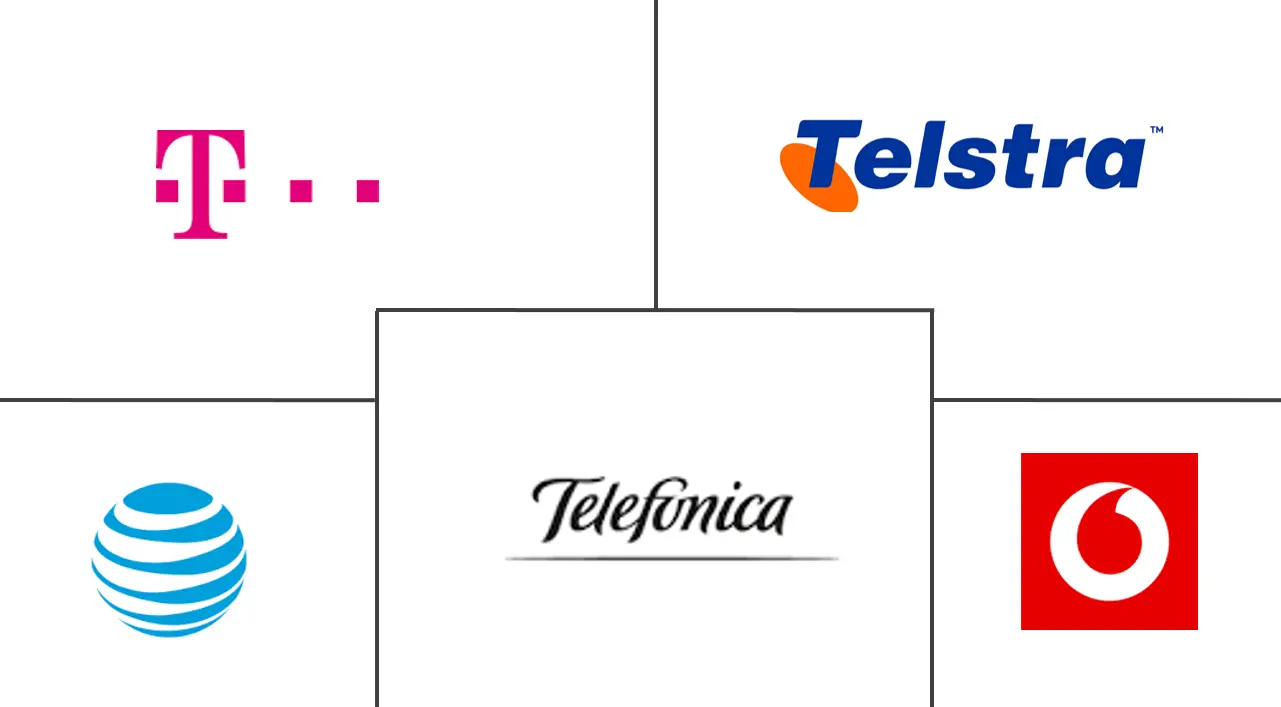Narrowband IoT Enterprise Application Market Size and Share
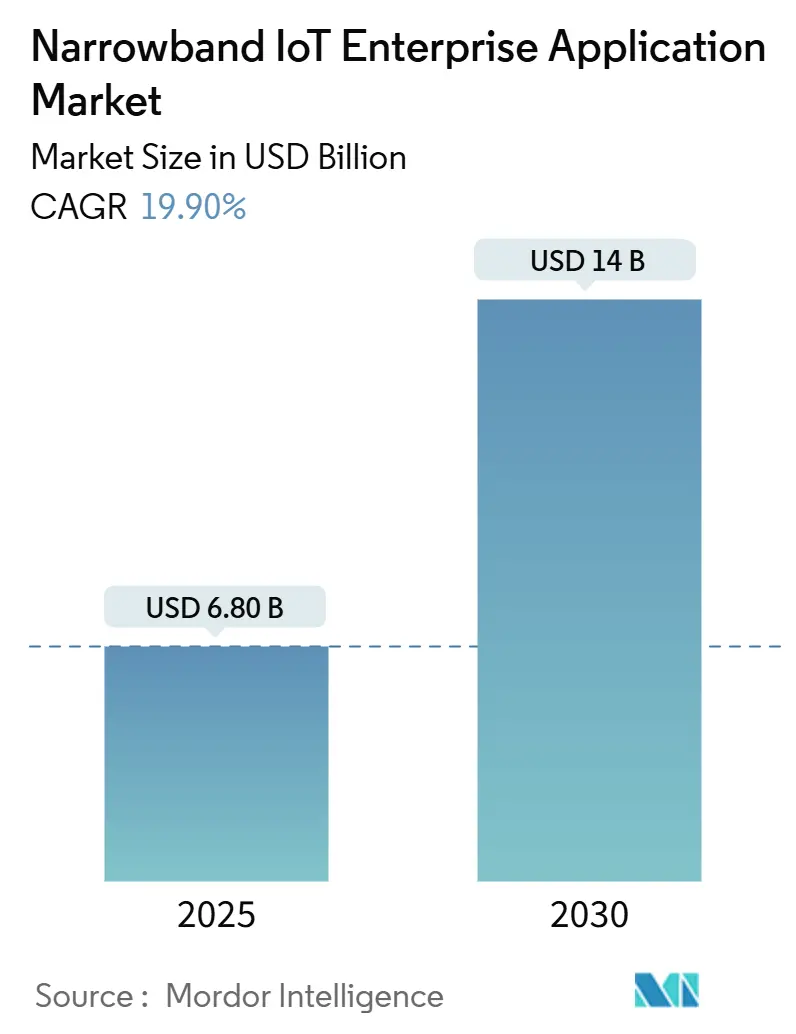
Narrowband IoT Enterprise Application Market Analysis by Mordor Intelligence
The Narrowband IoT Enterprise Application Market size is estimated at USD 6.80 billion in 2025, and is expected to reach USD 14 billion by 2030, at a CAGR of 19.90% during the forecast period (2025-2030).
The current growth phase reflects a shift from pilot projects to full-scale, mission-critical rollouts as governments back nationwide NB-IoT networks, energy-harvesting chipsets cut maintenance costs, and 3GPP Release-17 provides a stable migration path into 5G RedCap. Satellite NB-IoT constellations address the last-mile coverage gap, while falling module prices open the technology to smaller enterprises. Competitive intensity rises as satellite providers, mobile network operators, and LoRaWAN vendors position themselves around cost, coverage, and integration advantages.
Key Report Takeaways
- By enterprise size, large enterprises held 61% of the Narrowband IoT enterprise application market share in 2024, whereas SMEs are projected to expand at 23% CAGR through 2030.
- By application, smart metering led with 34% revenue share in 2024 in the Narrowband IoT enterprise application market; smart asset tracking is forecast to grow at 25% CAGR between 2025-2030.
- By end-user industry, energy and utilities accounted for 30% share of the Narrowband IoT enterprise application market size in 2024; transportation and logistics will advance at 24% CAGR to 2030.
- By geography, Asia-Pacific commanded 52% share in 2024 in the Narrowband IoT enterprise application market; Africa is projected to grow at 28% CAGR through 2030.
Global Narrowband IoT Enterprise Application Market Trends and Insights
Drivers Impact Analysis
| Driver | (~) % Impact on CAGR Forecast | Geographic Relevance | Impact Timeline |
|---|---|---|---|
| Government-backed nationwide NB-IoT rollouts | + 4.20% | China, EU core markets | Medium term (2-4 years) |
| Rapid smart-meter tenders in water and gas utilities | + 3.80% | Global, Europe and APAC focus | Short term (≤ 2 years) |
| 3GPP Release-17 integration with 5G RedCap | + 2.90% | Global, led by North America and Europe | Long term (≥ 4 years) |
| Satellite-enabled NB-IoT for remote assets | + 2.10% | Global, priority in Africa and remote APAC | Medium term (2-4 years) |
| Energy-harvesting NB-IoT chipsets | + 1.80% | Global, manufacturing regions | Long term (≥ 4 years) |
| Declining module costs enabling SME adoption | + 1.50% | Global | Short term (≤ 2 years) |
| Source: Mordor Intelligence | |||
Government-backed Nationwide NB-IoT Rollouts
China’s “Signal Upgrade” program targets 80,000 high-priority locations for NB-IoT coverage by 2025, creating network density that industrial users require for always-on sensors.[1]Ministry of Industry and Information Technology, “Signal Upgrade Initiative,” miit.gov.cn Parallel EU directives require 80% household coverage with smart metering, supported by CEN-CENELEC interoperability standards that reduce fragmentation. These mandates accelerate base-station upgrades and spectrum allocations, lower enterprise risk, and drive rapid module demand in utilities, manufacturing, and urban infrastructure.
Rapid Smart-Meter Tenders in Water and Gas Utilities
Global smart-meter installations are projected to double to 3.4 billion by 2033 as utilities modernize networks for leak detection and demand forecasting. In France, Veolia and Birdz have rolled out millions of NB-IoT water meters that deliver near real-time data while avoiding manual reads. Honeywell’s NB-IoT-enabled meters paired with Verizon connectivity illustrate how utility pilots transition into large-volume contracts when lifetime ownership costs fall.
3GPP Release-17 Integration with 5G RedCap
Release-17 defines Reduced Capability devices that bridge 4G LTE and full 5G, letting enterprises deploy dual-mode sensors now and migrate later without truck rolls.[2]Rohde & Schwarz, “5G RedCap Devices Explained,” rohde-schwarz.com Ericsson research shows RedCap devices achieve sub-10 Mbps throughput with markedly lower power draw, ideal for factory sensors and environmental monitors. GSMA’s Mobile IoT framework lists 252 commercial NB-IoT networks, giving enterprises the confidence that devices procured today remain compatible with future 5G rollouts.
Satellite-enabled NB-IoT for Remote Asset Monitoring
Sateliot’s 5G NB-IoT constellation integrates with standard SIM cards, merging terrestrial and non-terrestrial networks for true global reach. Telefónica field tests confirm roaming from space to ground networks, enabling oil, mining and agriculture firms to track equipment beyond cellular footprints. OQ Technology further extends coverage through Deutsche Telekom partnerships that fill maritime and desert gaps.
Restraints Impact Analysis
| Restraint | (~) % Impact on CAGR Forecast | Geographic Relevance | Impact Timeline |
|---|---|---|---|
| LoRaWAN price advantages in private utilities networks | –2.7% | North America and Europe | Short term (≤ 2 years) |
| Fragmented roaming SLAs across MNO footprints | –1.9% | Global | Medium term (2-4 years) |
| Lengthy and costly module certification processes | –1.6% | Global | Short term (≤ 2 years) |
| Limited rural coverage in developing regions | –1.4% | South America and Middle East | Medium term (2-4 years) |
| Source: Mordor Intelligence | |||
LoRaWAN Price Advantages in Private Utilities Networks
LoRaWAN modules remain cheaper than NB-IoT units and operate on unlicensed spectrum, letting utilities bypass recurring cellular fees. Private water utilities in rural zones often favor LoRa due to simple gateway deployments that avoid operator negotiations. The cost gap forces NB-IoT vendors to stress security, QoS and seamless integration with existing cellular assets when pitching to cost-sensitive buyers.
Fragmented Roaming SLAs across MNO Footprints
Permanent-roaming restrictions differ by country, so a device certified on one network may fail elsewhere, slowing multinational rollouts.[3]Telnyx, “IoT Roaming Restrictions Explained,” telnyx.com AT&T’s approval process can cost USD 175,000 and take almost 12 months, hampering time-to-market for global equipment suppliers. Multi-IMSI and eUICC solutions mitigate some pain, yet enterprises still face legal and operational uncertainty every time they cross borders.
Segment Analysis
By Enterprise Size: SMEs Drive Adoption through Simplified Deployment Models
SMEs are the fastest-growing customer group, expanding at 23% CAGR despite large enterprises retaining 61% share of the Narrowband IoT enterprise application market in 2024. The uptick stems from sub-USD 10 modules, cloud-first dashboards, and managed services that shield smaller firms from integration complexity. Industrial case studies show payback periods under 24 months when sensors prevent unplanned downtime. Large enterprises continue to dominate multistate deployments in utilities and automotive plants, leveraging dedicated IT teams and economies of scale for platform licensing.
The total addressable Narrowband IoT enterprise application market size for SMEs is projected to reach USD 3.8 billion by 2030, while large-enterprise spending climbs to USD 10.2 billion. Energy-harvesting reference designs from HiSilicon allow “install-and-forget” sensors in mid-sized factories that lack maintenance staff, making NB-IoT economically viable at smaller scale.
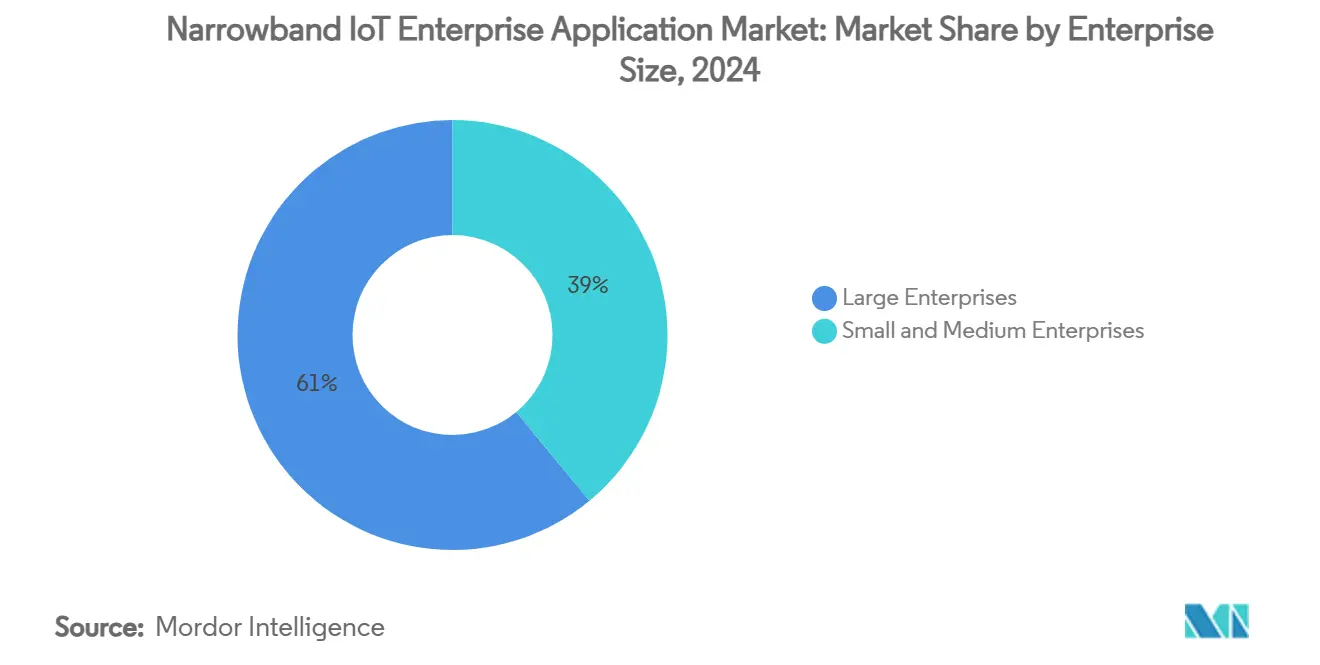
By Application: Smart Asset Tracking Moves Beyond Traditional Metering
Smart metering accounted for 34% of Narrowband IoT enterprise application market share in 2024 on the back of utility mandates, yet smart asset tracking will grow at 25% CAGR to 2030 as logistics and industrial firms demand real-time visibility. Container operators that adopt NB-IoT tags report fewer demurrage fees and improved customer SLAs.
Asset-tracking growth pushes the total Narrowband IoT enterprise application market size for tracking solutions to USD 4.1 billion by 2030, overtaking new meter installations after 2028. Combined with AI analytics, NB-IoT tags feed predictive ETAs into transport management systems, improving route planning and reducing emissions.
By End-user Industry: Transportation and Logistics Disrupts Utility Dominance
Energy and utilities held a 30% share in 2024 as regulators required interval data for gas and water. However, the transportation and logistics segment is projected to expand at 24% CAGR through 2030 as supply chain digitalization becomes board-level priority. T-Mobile reports double-digit growth in NB-IoT fleet subscriptions, driven by cold-chain monitoring that must meet pharmaceutical compliance.
Under Industry 4.0, manufacturers adopt private LTE/NB-IoT networks on shop floors to enable condition-based maintenance; productivity gains up to 25% have been recorded in pilot plants. Mining and oil and gas operators use NB-IoT for safety sensors in underground shafts where Wi-Fi is unreliable.
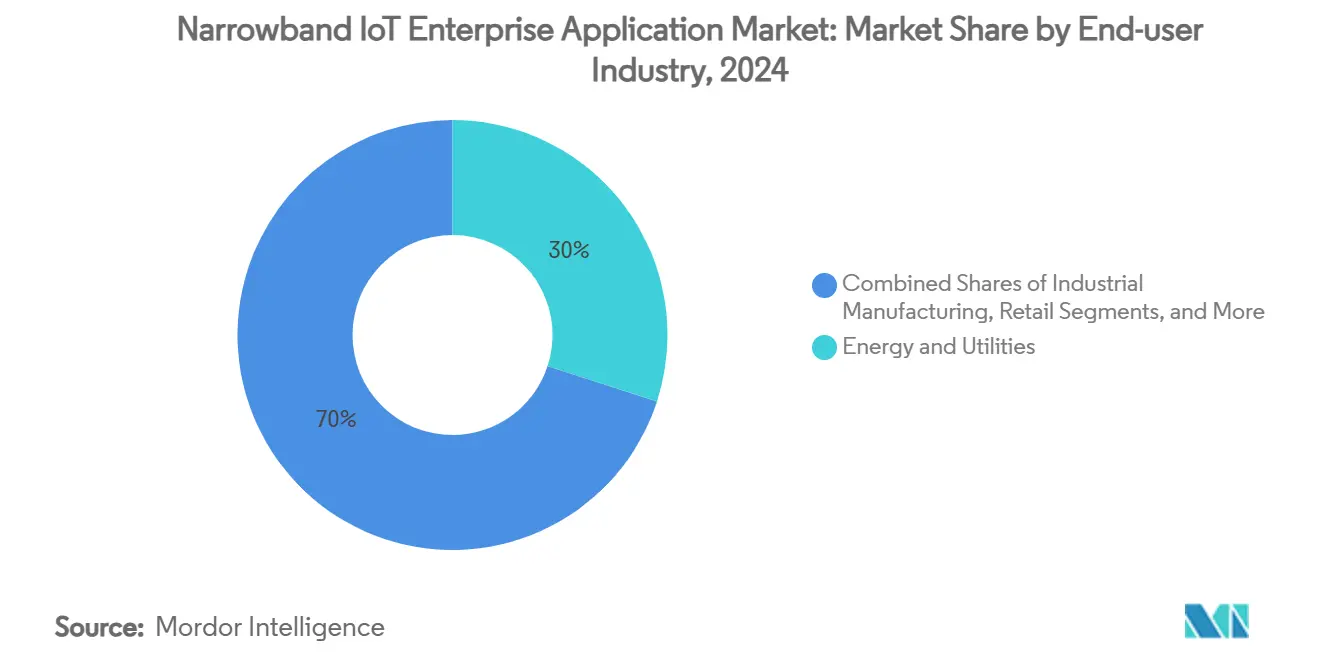
Note: Segment shares of all individual segments available upon report purchase
Geography Analysis
APAC commanded 52% of 2024 revenue as China surpassed 2.3 billion cellular IoT connections, outnumbering smartphones. Beijing’s 5.5G build-out covers 70% of the Fourth Ring Road, enabling dense deployments for smart traffic lights and municipal waste bins. Indonesia’s PLN and Huawei fiber program extends backbone capacity that rural NB-IoT base stations rely on. Singapore, Australia, and South Korea top GSMA’s Digital Nations Index, while markets such as Cambodia and Nepal still show double-digit adoption potential.[4]GSMA, “Digital Nations Index,” gsma.com
Africa is expected to register a 28% CAGR outlook as the African Union’s Continental AI Strategy and Broadband Africa Vision 2030 focus on digital inclusion. South Africa’s plan to sunset 2G/3G by 2027 forces utilities and agriculture to shift to LPWA options, and satellite NB-IoT fills extreme coverage gaps. National broadband plans exist in 84% of countries, creating policy frameworks for public–private partnerships.
Europe records steady expansion through legally binding smart-meter targets and CEN-CENELEC standards that ensure cross-border interoperability. North America sees rising industrial private-cellular projects, although roaming fragmentation limits seamless multinational coverage. South America and the Middle East are in early diffusion stages; economic constraints and spotty rural coverage moderate growth until satellite-terrestrial hybrids mature.
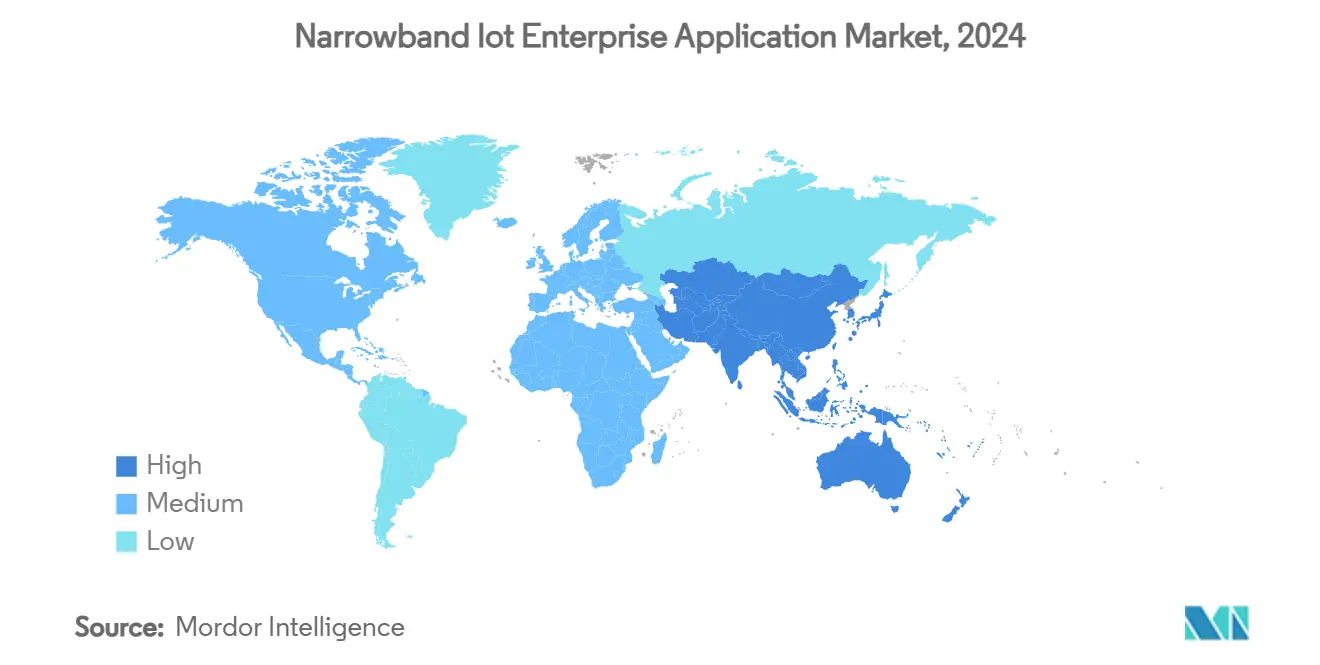
Competitive Landscape
Competition remains fragmented across network, module and application layers. Vodafone manages 205 million IoT connections, offering one-stop device management for multinational clients. China Unicom leverages government contracts to scale NB-IoT in smart cities, while Deutsche Telekom positions itself as an integrator for NTN-IoT through alliances with Skylo and OQ Technology.
Satellite specialists like Sateliot and OQ Technology erode terrestrial exclusivity by extending coverage into maritime, desert, and polar zones. LoRaWAN vendors such as Semtech retain cost leadership in private utilities, causing price pressure on NB-IoT module suppliers. Chipset makers HiSilicon, Nowi, and Sequans focus on energy harvesting to slash maintenance, a persuasive point for SMEs.
Intellectual-property stakes rise as firms patent Release-17 features and Integrated Sensing and Communication (ISAC) capabilities for 6G. The Global Telco AI Alliance, SK Telecom, Deutsche Telekom, e&, Singtel and SoftBank, integrates generative AI into IoT service portals to reduce customer churn. The diversified landscape implies healthy rivalry, yet consolidation is likely among smaller module vendors unable to fund multi-standard R&D.
Narrowband IoT Enterprise Application Industry Leaders
-
Vodafone Group PLC
-
AT&T Inc.
-
Telstra Corporation Limited
-
Telefonica S.A.
-
Deutsche Telekom AG
- *Disclaimer: Major Players sorted in no particular order
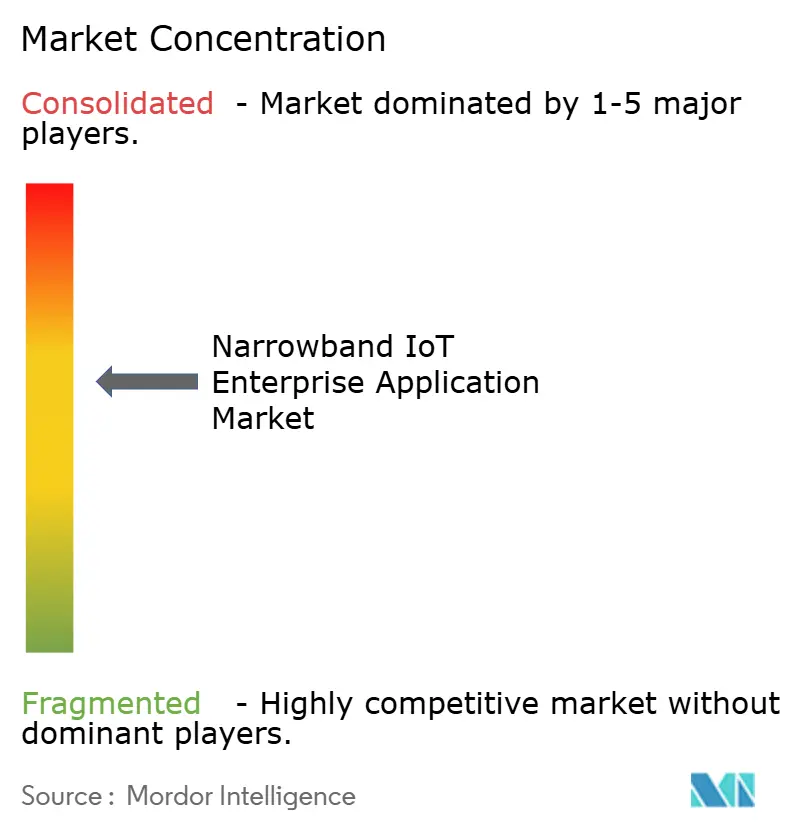
Recent Industry Developments
- March 2025: Honeywell and Verizon integrated 5G into NB-IoT smart meters for remote upgrades and demand forecasting.
- February 2025: OQ Technology partnered with Aramco Digital to extend NTN-IoT across energy sites; Myriota and Viasat launched HyperPulse NB-IoT service.
- February 2025: Sequans and e-peas showcased energy-harvesting LTE-M/NB-IoT reference designs eliminating battery swaps.
- January 2025: Skylo and Deutsche Telekom established global NB-IoT roaming between terrestrial and satellite networks.
Global Narrowband IoT Enterprise Application Market Report Scope
NB-IoT is a standards-based low power wide area (LPWA) technology that is developed to enable a wide range of new IoT devices and services. It significantly improves the system capacity, power consumption of user devices, and spectrum efficiency, especially in deep coverage. The technology also provides wide coverage; many connections; low data rates, costs, and power consumption; and optimized architecture. It perfectly satisfies the need for IoT deployment in numerous industries as well as applications.
| Small and Medium Enterprises |
| Large Enterprises |
| Smart Metering |
| Smart Asset Tracking |
| Smart Governance |
| Facility Management Services |
| Security and Connected Industrial Assets |
| Energy and Utilities |
| Retail |
| Industrial Manufacturing |
| Transportation and Logistics |
| Other End-user Industries |
| North America |
| South America |
| Europe |
| Asia-Pacific |
| Middle East and Africa |
| By Enterprise Size | Small and Medium Enterprises |
| Large Enterprises | |
| By Application | Smart Metering |
| Smart Asset Tracking | |
| Smart Governance | |
| Facility Management Services | |
| Security and Connected Industrial Assets | |
| By End-user Industry | Energy and Utilities |
| Retail | |
| Industrial Manufacturing | |
| Transportation and Logistics | |
| Other End-user Industries | |
| Geography | North America |
| South America | |
| Europe | |
| Asia-Pacific | |
| Middle East and Africa |
Key Questions Answered in the Report
What is the current size of the Narrowband IoT enterprise application market?
The market stands at USD 6.8 billion in 2025 and is projected to reach USD 14 billion by 2030.
Which segment is growing the fastest?
Smart asset tracking is expanding at 25% CAGR between 2025-2030, outpacing traditional smart-meter deployments.
Why are SMEs adopting NB-IoT more rapidly now?
Falling module prices, cloud dashboards and energy-harvesting chipsets remove the technical and maintenance barriers that previously limited SME adoption.
Which region shows the significant growth potential?
Africa is expected to register a 28% CAGR outlook to 2030 as continental broadband and AI strategies boost digital inclusion.
How does satellite NB-IoT complement terrestrial networks?
Satellite constellations such as Sateliot and OQ Technology provide coverage in maritime, desert and other remote zones where terrestrial towers are impractical.
What key restraint could slow NB-IoT expansion?
Cost-competitive LoRaWAN private networks in utilities and fragmented roaming agreements across mobile operators pose near-term challenges to global NB-IoT rollouts.
Page last updated on:
